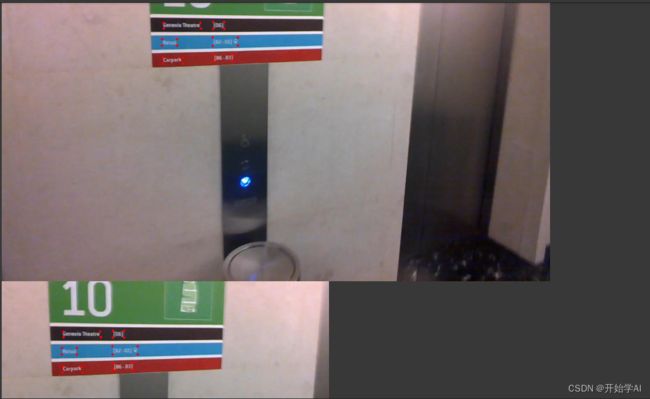文字区域检测数据增强(一)随机裁剪
过程
由于文字标注区域可以为任意四边形,为了不把文字标注区域切分成两个区域,因此首先需要得到所有标注框的最外界坐标,如下图红色框的获取过程。
然后根据红色框与图像边界的距离进一步随机生成裁剪坐标,如生成蓝色虚线框的左上角与右下角坐标。
随后进行区域剪裁与Bbox调整。
BBox的坐标更新,只需要将原来的BBox的值减去裁剪区域的起始坐标,如减去蓝色框的起始坐标。如下:
[bbox[0][0] - crop_x_min, bbox[0][1] - crop_y_min],
[bbox[1][0] - crop_x_min, bbox[1][1] - crop_y_min],
[bbox[2][0] - crop_x_min, bbox[2][1] - crop_y_min],
[bbox[3][0] - crop_x_min, bbox[3][1] - crop_y_min]
代码
import random
import math
import cv2
import numpy as np
point_size = 1
point_color = (0, 0, 255) # BGR
thickness = 4 # 可以为 0 、4、8
def crop_img(img, bboxes):
h = img.shape[0]
w = img.shape[1]
x_min = w
y_min = h
x_max = 0
y_max = 0
# 拿到所有框的综合的最外界结果,保证不会把框切成两块
for bbox in bboxes:
x0 = min(x_min, bbox[0][0]) # 左上角x
y0 = min(y_min, bbox[0][1]) # 左上角y
x1 = min(x_min, bbox[1][0]) # 左下角x
y1 = max(y_max, bbox[1][1]) # 左下角y
x2 = max(x_max, bbox[2][0]) # 右下角x
y2 = max(y_max, bbox[2][1]) # 右下角y
x3 = max(x_max, bbox[3][0]) # 右上角x
y3 = min(y_min, bbox[3][1]) # 右上角y
d_to_left = min(x0, x1, x2, x3)
d_to_top = min(y0, y1, y2, y3)
d_to_right = w - max(x0, x1, x2, x3)
d_to_down = h - max(y0, y1, y2, y3)
# 随机生成裁剪坐标
crop_x_min = int(min(x0, x1, x2, x3) - random.uniform(d_to_left // 2, d_to_left))
crop_y_min = int(min(y0, y1, y2, y3) - random.uniform(d_to_top // 2, d_to_top))
crop_x_max = int(max(x0, x1, x2, x3) + random.uniform(d_to_right // 2, d_to_right))
crop_y_max = int(max(y0, y1, y2, y3) + random.uniform(d_to_down // 2, d_to_down))
# #固定坐标裁剪
# crop_x_min = 100
# crop_y_min = 0
# crop_x_max = 1230
# crop_y_max = 900
# # 确保在边界之内
# crop_x_min = max(0, crop_x_min)
# crop_y_min = max(0, crop_y_min)
# crop_x_max = min(w, crop_x_max)
# crop_y_max = min(h, crop_y_max)
# 裁剪图像
crop_img = img[crop_y_min:crop_y_max, crop_x_min:crop_x_max]
# print(bboxes)
# 调整坐标
crop_bbox = []
for bbox in bboxes:
crop_bbox.append([[bbox[0][0] - crop_x_min, bbox[0][1] - crop_y_min],
[bbox[1][0] - crop_x_min, bbox[1][1] - crop_y_min],
[bbox[2][0] - crop_x_min, bbox[2][1] - crop_y_min],
[bbox[3][0] - crop_x_min, bbox[3][1] - crop_y_min]
])
# print(crop_bbox)
return crop_img, crop_bbox
测试
测试选取了ICDAR2015数据集的一张图片,bboxes是标注的坐标,为一个列表。
img = cv2.imread("/content/drive/Shareddrives/OCR/data/Crop_data/img_1.jpg")
img1 = img.copy()
bboxes = [[(377,117),(463,117),(465,130),(378,130)],
[(493,115),(519,115),(519,131),(493,131)],
[(374,155),(409,155),(409,170),(374,170)],
[(492,151),(551,151),(551,170),(492,170)],
[(376,198),(422,198),(422,212),(376,212)],
[(494,190),(539,189),(539,205),(494,206)]]
for box in bboxes:
for p in box:
cv2.circle(img1, p, point_size, point_color, thickness)
# cv2_imshow(img)
cv2_imshow(img1)
crop_img, crop_bbox = crop_img(img,bboxes)
# cv2_imshow(crop_img)
for box in crop_bbox:
for p in box:
for i in range(2):
if p[i] < 0:
p[i] = 0
p = tuple(p)
cv2.circle(crop_img, p, point_size, point_color, thickness)
cv2_imshow(crop_img)
